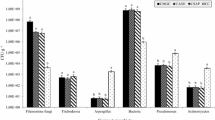Abstract
Backyard composting is widely used to process vegetable, fruit and garden wastes (biowastes) in gardens. Unfortunately, little is known about the hygienisation efficiency during this small-scale composting process. In a 6-month experiment, the eradication of tobacco mosaic virus (TMV), Plasmodiophora brassicae, Heterodera schachtii and of tomato seeds was followed during corn-posting in four 200–1 vessels. In conformity with the German BioAbfV norms which were used as guideline for this research, the pathogens were incorporated as TMV-infected tobacco leaves, as a mixture of clubroot-infected cauliflower roots and infested soil, as cysts or as seeds packed in nylon fibre nets. Two vessels were totally filled; two others were half-filled. At the end of the 6-month composting period, only TMV was completely eliminated, while H. schachtii and the tomato seeds were almost completely eliminated. On the other hand, P. brassicae survived the composting process. Destruction of the tomato seeds, of TMV and of H. schachtii could partly be explained on the basis of heat treatment. Other factors may have contributed to the sanitising effect observed during this rather low-temperature composting process.
Access this chapter
Tax calculation will be finalised at checkout
Purchases are for personal use only
Preview
Unable to display preview. Download preview PDF.
Similar content being viewed by others
References
Avgelis AD, Manios VI (1989) Elimination of tomato mosaic virus by composting tomato residues. Neth J Plant Pathol 95 (3): 167–170
Bioabf V (1998) Ordinance on the utilisation of bio-wastes on land used for agricultural, silvicultural and horticultural purposes. Bundesministerium für Umwelt, Naturschutz und Reaktorsicherheit, Bonn, Germany, 49 pp
Bollen GJ (1985) The fate of plant pathogens during composting of crop residues. In: Gasser JKR (ed) Composting of agricultural and other wastes. Elsevier, London, pp 282–290
Bollen GJ (1993) Factors involved in inactivation of plant pathogens during composting of crop residues. In: Hoitink HAJ, Keener KM (eds) Science and engineering of composting. The Ohio State University, Ohio, pp 301–318
Bollen GJ, Volker D (1996) Phytohygienic aspects of composting. In: De Bertoldi M, Sequi P, Lemmes B, Papi T (eds) The science of composting–Part 1. Chapman and Hall, London, pp 247–254
Buczacki ST, Tocopeus H, Mattusch P, Johnston TD, Dixon GR, Hobolth LA (1975) Study of physiologic specialization in Plasmodiophora brassicae: proposals for rationalisation through an international approach. Trans Br Mycol Soc 65: 295–303
Clarke AJ, Perry RN (1977) Hatching of cyst-nematodes. Nematologica 23: 350–368
Cops S (1997) Fytohygiënisatie van GFT— en groenafval door aërobe en anaerobe compostering. M Sc Dissertation. Katholieke Universiteit Leuven, Leuven, 115 pp
Golueke CG (1982) When is compost “safe”? A review of criteria for assessing the destruction of pathogens in composting. Biocycle March/April: 28–38
Grundy AC, Green JM, Lennartsson M. (1998) The effect of temperature on the viability of weed seeds in compost. Compost Sci Util 6 (3): 26–33
Herrmann I, Meissner S, Bächle E, Rupp E, Menke G, Grossmann F (1994) Einfluß des Rotteprozesses von Bioabfall auf das Überleben von Phytopathogenen Organismen und von Tomatensamen. Z Pflanzenkr Pflanzenschutz 101 (1): 48–65
Hoitink HAJ, Fahy PC (1986) Basis for the control of soilborne plant pathogens with composts. Annu Rev Phytopathol 24: 93–114
Idelmann M, Marciniszyn E, Waldow F (1997) FandE Vorhaben Phytohygiene der Bioabfallkompostierung. Abschlußbericht Februar 1997. PlanCoTec, Witzenhausen, Germany, 8 pp
Kegler H, Fuchs E, Spaar D, Kegler J (1995) Viren im Boden und Grundwasser. Arch Phytopathol Pflanz 29: 349–371
LAGA Merkblatt MI0 (1994) Qualitätskriterien und Anwendungsempfehlungen für Kompost. Endfassung zur Vorlage für die 44. ATA-Sitzung am 17./18. Januar 1995. Vorgelegt vor der LAGA-AG Biokompost. Berlin, 12 Dezember 1994, 88 pp
Ryckeboer J, Coosemans J, Cops S (1997a) Hygiënisatie tijdens het thuiscomposteren: Worden plantenziekten afgedood? Deel 1: Literatuurstudie. Humus News 13 (1): 11–12
Ryckeboer J, Coosemans J, Cops S (1997b) Hygiënisatie tijdens het thuiscomposteren: Worden plantenziekten afgedood? Deel 2: Proefopzet. Humus News 13 (2): 9–11
Ryckeboer J, Coosemans J, Cops S (1997e) Hygiënisatie tijdens het thuiscomposteren: Worden plantenziekten afgedood? Deel 3: Resultaten. Humus News 13 (3): 5–8
Ryckeboer J, Coosemans J, Cops S (1997d) De hygiënisatie van groente-, fruit-, en tuinafval tijdens het composteren. Vlacovaria 3: 6–10
Walkey DGA (1991) Applied plant virology, 2nd edn. Chapman and Hall, London, 217 pp Wijnen AP, Volker D, Bollen GJ (1983) De lotgevallen van pathogene schimmels in een composthoop. Gewasbescherming 14:5
Yuen GY, Raabe RD (1984) Effects of small-scale aerobic composting on survival of some fungal plant pathogens. Plant Dis 68: 134–136
Author information
Authors and Affiliations
Editor information
Editors and Affiliations
Rights and permissions
Copyright information
© 2002 Springer-Verlag Berlin Heidelberg
About this paper
Cite this paper
Ryckeboer, J., Cops, S., Coosemans, J. (2002). The Fate of Plant Pathogens and Seeds During Backyard Composting of Vegetable, Fruit and Garden Wastes. In: Insam, H., Riddech, N., Klammer, S. (eds) Microbiology of Composting. Springer, Berlin, Heidelberg. https://doi.org/10.1007/978-3-662-08724-4_44
Download citation
DOI: https://doi.org/10.1007/978-3-662-08724-4_44
Publisher Name: Springer, Berlin, Heidelberg
Print ISBN: 978-3-642-08705-9
Online ISBN: 978-3-662-08724-4
eBook Packages: Springer Book Archive




